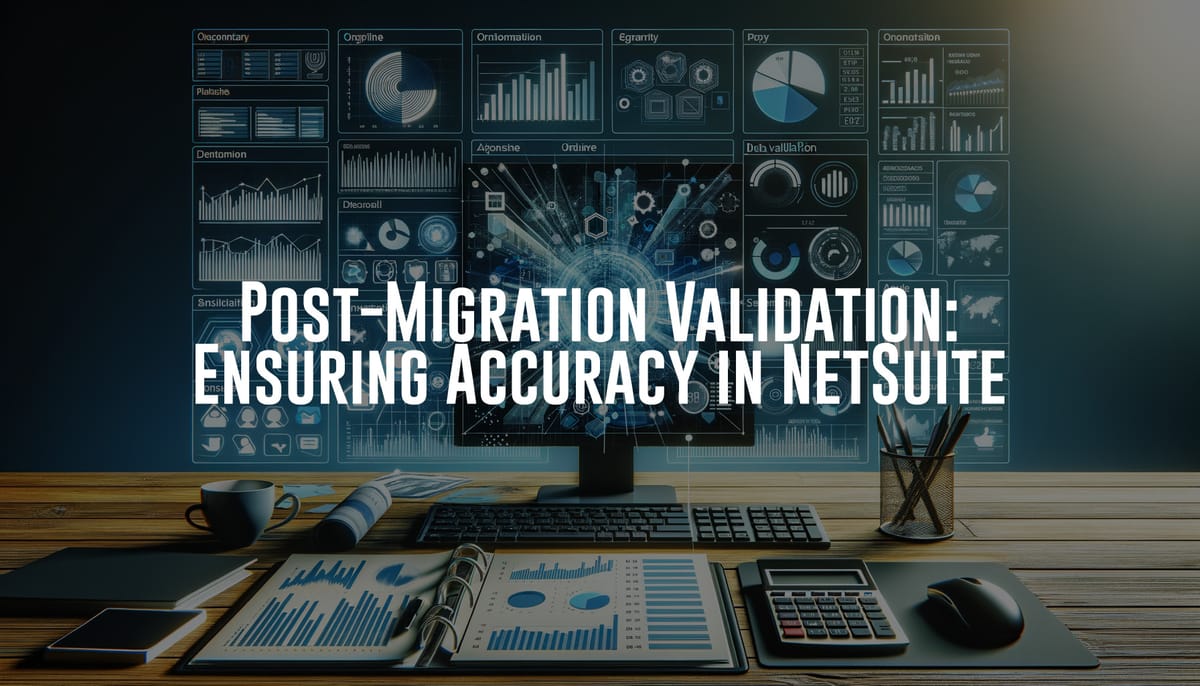Post-Migration Validation: Ensuring Accuracy in NetSuite
Discover how to validate migrated AR data in NetSuite, using essential tools and techniques, and understand the importance of user acceptance testing (UAT) in this detailed guide.

Migrating to a new ERP system is a significant milestone for any organization. NetSuite, with its comprehensive capabilities, offers a robust platform for managing various business processes. However, the real challenge often lies in ensuring that your data, specifically accounts receivable (AR) data, has been accurately migrated. This comprehensive guide will delve into how to validate migrated AR data in NetSuite, explore the essential tools and techniques for data validation, and underscore the critical importance of user acceptance testing (UAT) in the validation process.
How to Validate Migrated AR Data in NetSuite
1. Data Reconciliation
One of the first steps in validating migrated AR data is to perform data reconciliation. This involves comparing the data from your legacy system with the data in NetSuite. Key focus areas include:
- Outstanding Invoices: Verify that all outstanding invoices from the old system have been accurately transferred.
- Customer Balances: Ensure that customer balances are consistent between the old and new systems.
- Payment Applied: Confirm that payments applied to customer invoices before migration reflect correctly in NetSuite.
2. Use of SuiteAnalytics
NetSuite's SuiteAnalytics is an invaluable tool for data validation. It provides customizable reports and saved searches that can be tailored to identify discrepancies in migrated data. Some effective reports include:
- Invoice Aging Reports: These help ensure that your invoice aging details are accurate post-migration.
- Customer Statement Reports: Validate that customer statements match those from your previous system.
3. Data Integrity Checks
Conducting data integrity checks is another crucial step. This involves:
- Duplication Check: Ensure no duplicate entries exist for invoices, payments, or customer details.
- Data Format Validation: Verify that data formats align with what is required in NetSuite.
Tools and Techniques for Data Validation
SuiteFlow
NetSuite’s SuiteFlow can be leveraged to automate validation processes. By setting up custom workflows, you can create automated checks that flag discrepancies and inconsistencies in your data.
Data Import-Export Tool
Utilize NetSuite's data import-export tool to facilitate easy data comparison. By exporting data into CSV files, you can use spreadsheet functions to align and compare critical data points between systems.
Third-Party Tools
There are several third-party tools available that can assist with data validation, offering more advanced capabilities such as predictive analytics and machine learning to detect potential issues.
Importance of User Acceptance Testing (UAT) in the Validation Process
What is UAT?
User Acceptance Testing (UAT) is a phase in the deployment process where actual users test the newly implemented system using real-world scenarios to confirm that it behaves as expected. For AR data validation, UAT is indispensable.
Benefits of UAT
- Real-World Testing: UAT ensures that the migrated data and the system functionality meet user requirements in real-world usage scenarios.
- Early Detection of Issues: It helps in early identification of potential issues that may not have been caught during system testing or data migration phases.
- User Confidence: Conducting UAT fosters user confidence in the new system, as they have firsthand experience with its accuracy and reliability.
UAT Process for AR Data Validation
- Define Test Scenarios: Collaborate with end-users to define test scenarios that cover all critical aspects of AR processes.
- Setup Test Environment: Ensure a separate and safe test environment loaded with migrated data for the execution of UAT.
- Execute Test Cases: Users execute the test cases and document any discrepancies or issues encountered.
- Feedback Loop: Create a feedback loop where issues are addressed, and solutions are implemented before final system go-live.
Conclusion
Validating migrated AR data in NetSuite is a meticulous but essential process to ensure data integrity and system reliability. By employing robust data reconciliation methods, leveraging tools like SuiteAnalytics, and rigorously conducting UAT, organizations can achieve a seamless transition to NetSuite. The key is to approach validation as an ongoing process rather than a one-time task, ensuring accuracy and reliability at every step. Happy migrating!





